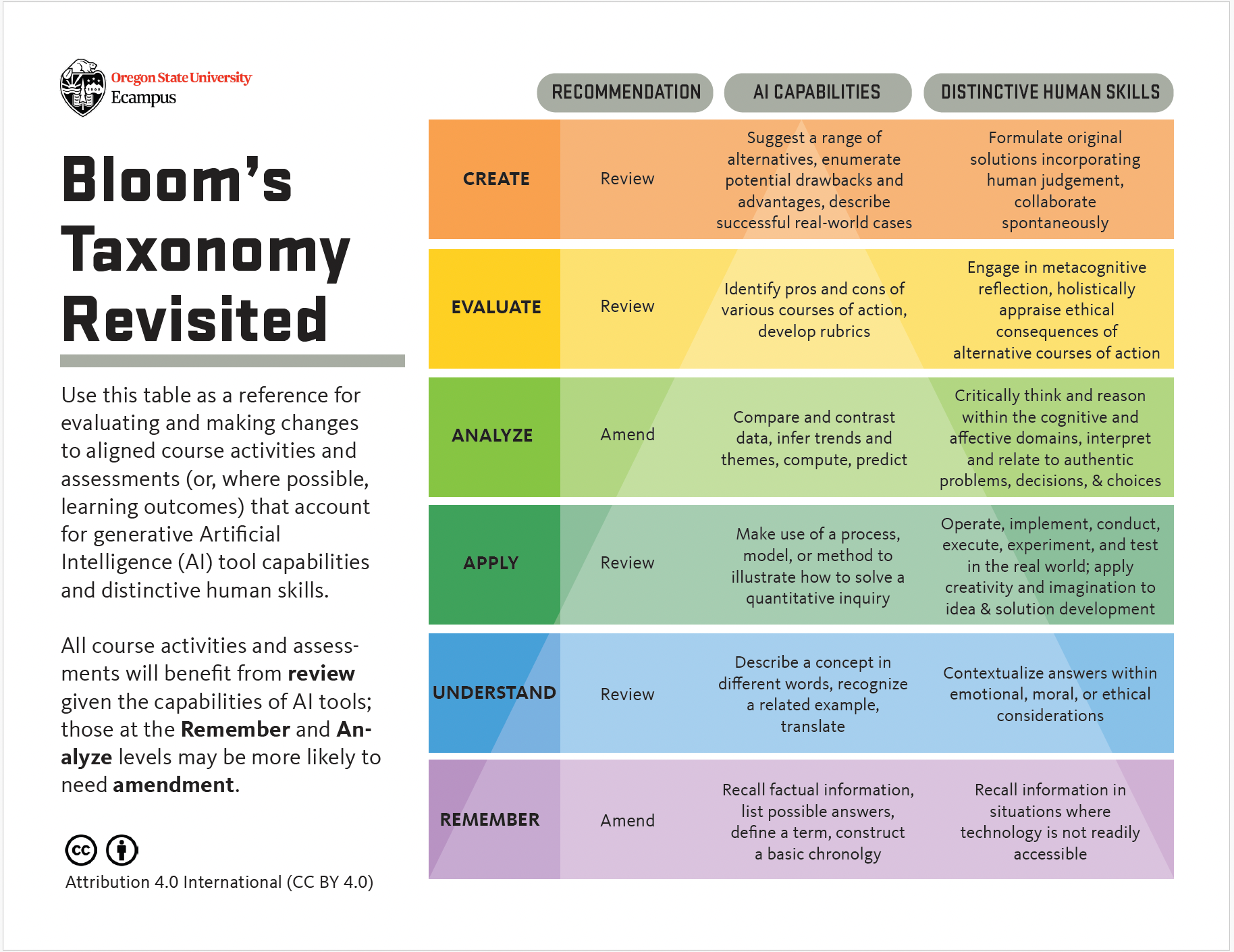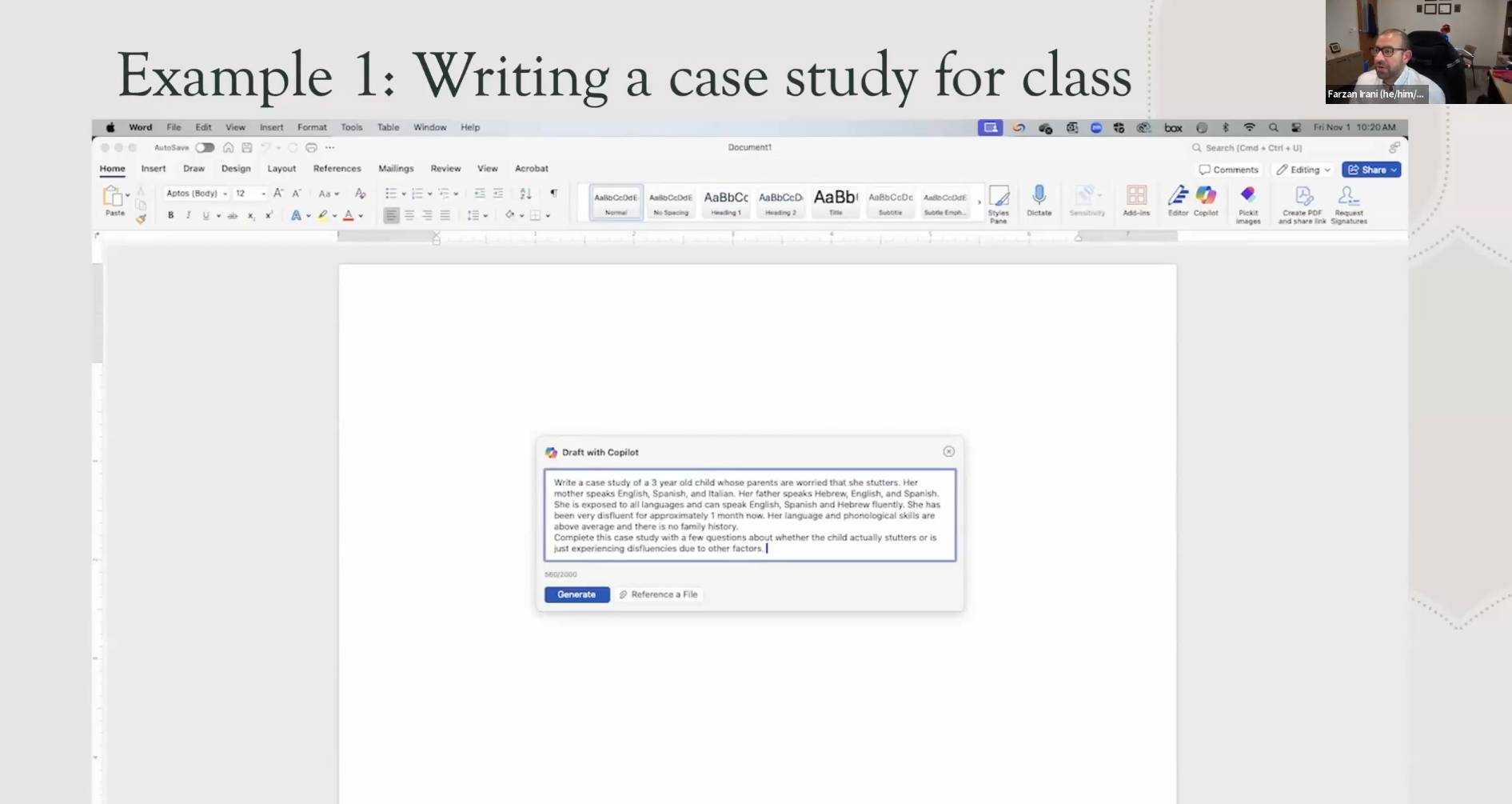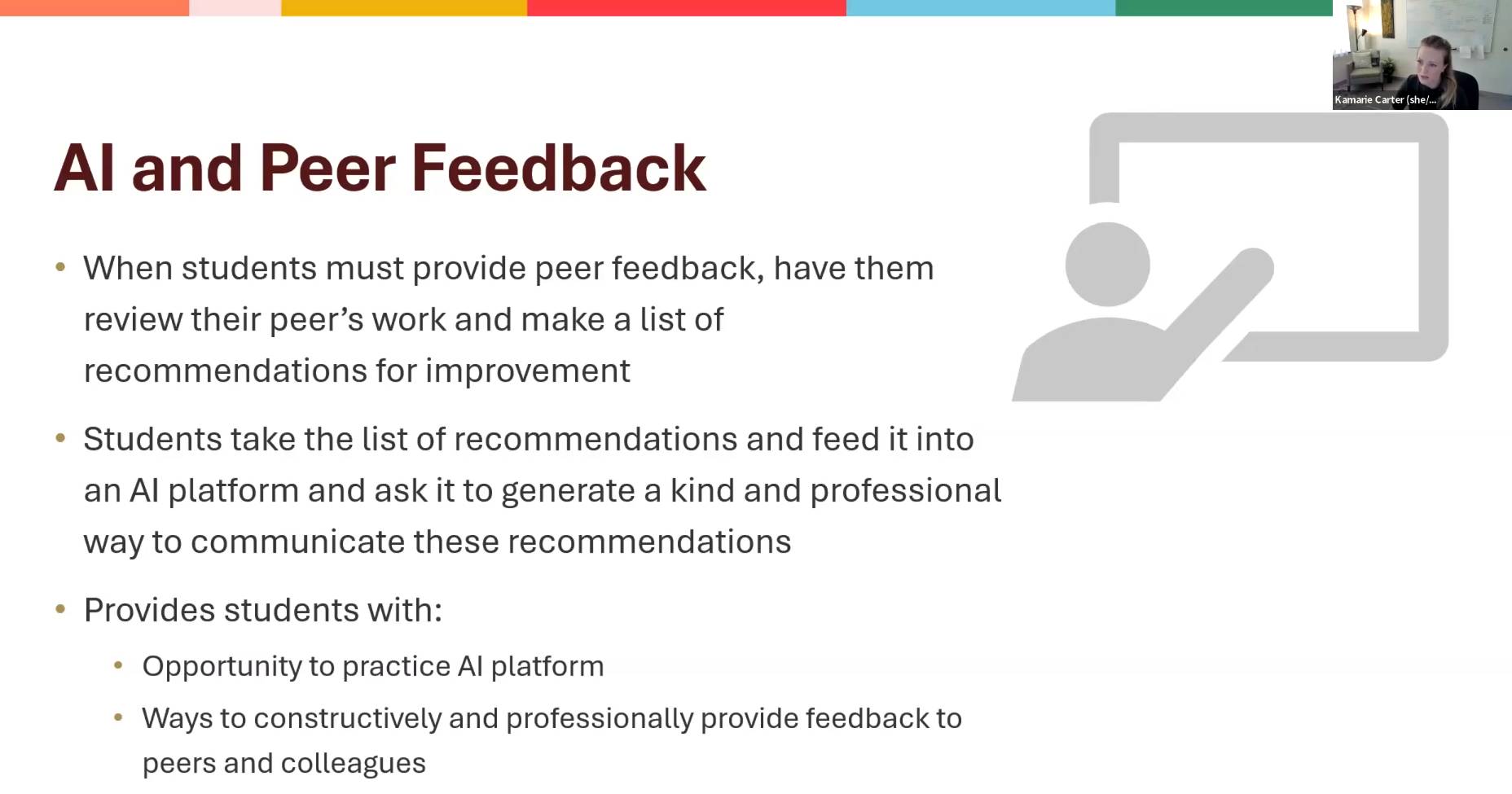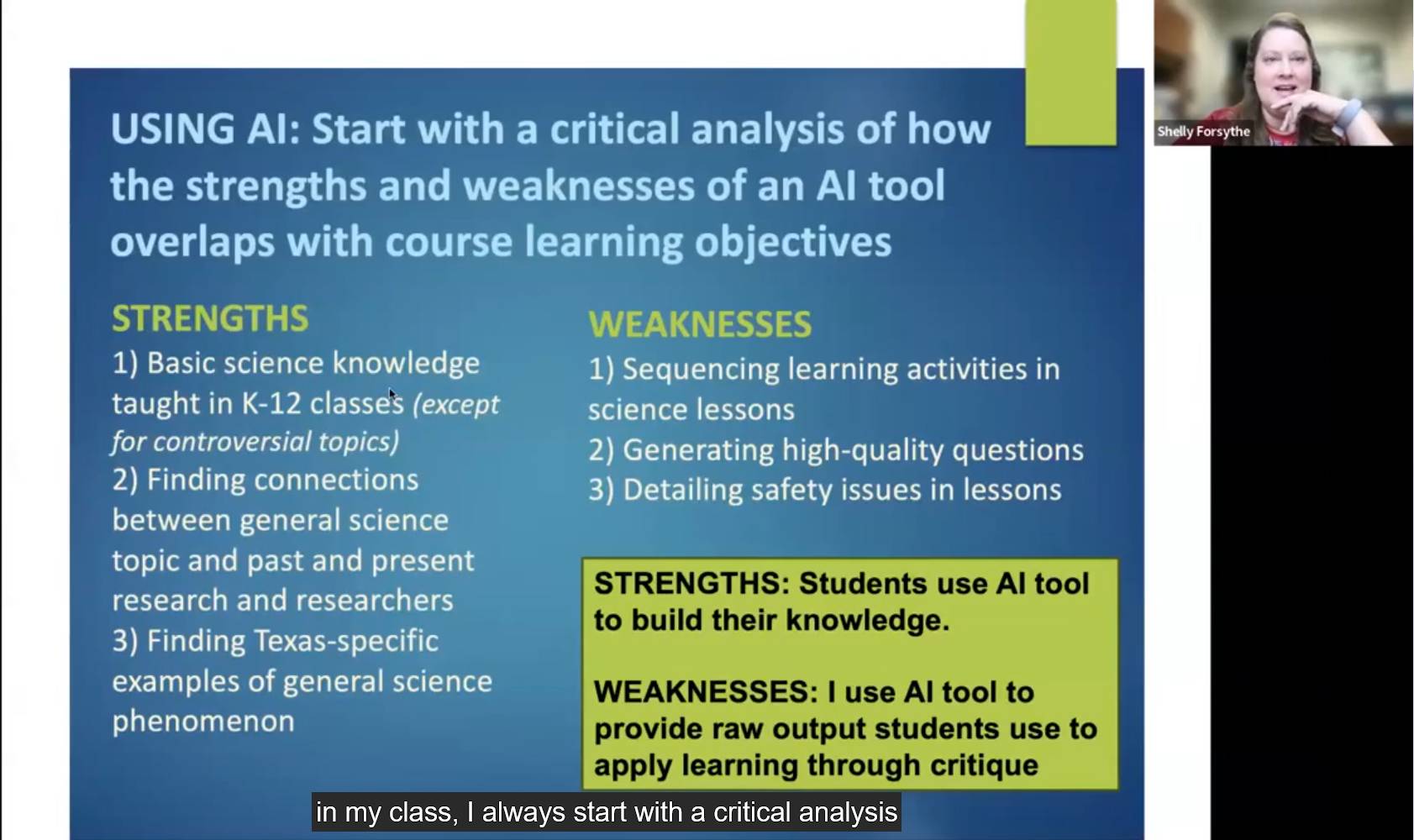AI in Higher Education
The use of artificial intelligence will continue to expand and grow for years to come, making AI an inevitable part of the workforce that many of our students will encounter and use after graduation. How can we best prepare them?
270% Increased AI Use by Businesses
#1 Fastest growing skill
Jobs predicted to receive a significant productivity boost through AI, and therefore likely to integrate roles and responsibilities with AI (Dataforce, 2023), include Content Creation, Healthcare, Design, Manufacturing, Customer Service, Finance, Education, and more.
Guiding Student Use of AI
A critical evaluation of AI use in your unique teaching contexts and in regard to your learning outcomes can help determine its place in your practice. AI holds significant potential for enhancing educational experiences, but you may find that it is not always the best fit for your particular class or specific assignments within your course. Some subject matter might not lend itself well to AI integration. Additionally, the current limitations of AI technology, such as its inability to fully understand complex human emotions and nuances, may lead you to conclude that traditional teaching methods are more effective for your specific learning outcomes.
If you decide that AI has a place in your courses, there are a few practices to consider when teaching:
Help Ensure Academic Integrity
Academic Integrity remains a pillar of the education experience at Texas State University. With the advancement of generative AI (genAI), concern for academic integrity has risen in higher education. While creating assignments or assessments that are “AI-proof” is extremely difficult, there are methods and practices that faculty can engage in to ensure academic honesty, integrity, and success in their classes.
Making Integrity Relevant
Be open and clear about the role of AI in the course and students’ learning. When students recognize how learning connects to their goals, they are less likely to resort to dishonest shortcuts. Explaining why an assignment is relevant to students and describing what skills or knowledge they will gain as a result of completing it helps students see the value in original work and academic integrity.

Clarify
Use icons to show AI usage in assignments: a stop sign for no AI, a caution sign for limited AI, and a checkmark for full AI use. Quick visuals help students identify and assess AI’s role in learning.

Elaborate
Utilize additional methods of communication such as Canvas announcements and discussion, in-class communications, etc. to clearly explain the parameters of AI in a course.

Co-create
Foster a sense of agency and ownership among students by dedicating class time to co-creating AI policies. When students feel invested, they're less likely to resort to dishonest behaviors.
![]() To learn more about ethical considerations for AI, read our Frequently Asked Questions About AI.
To learn more about ethical considerations for AI, read our Frequently Asked Questions About AI.
Talk With Your Students About AI
Regardless of whether you permit extensive, limited, or no use of AI in your classes, it is crucial to clearly communicate expectations to students. It is recommended that you discuss the use of AI with your students early in the semester.
You can learn more by watching this short video clip of Dr. Rachel Davenport talking about AI discussions with students.
-
Tips for Talking About AI With Your Students
-
Be Clear
Be clear about expectations. Clearly state, in multiple places including the syllabus, if AI can be used in the class and, if so, what the parameters are for the use of AI.
Faculty members are encouraged to inform students when their work is submitted to an AI platform for purposes such as grading or review.
-
Talk About AI in the Workplace
Talk about the use of AI in the field of study that students are learning. As previously mentioned, AI is becoming an inevitable part of the workforce that many of our students will engage with after graduation. It is crucial that they are equipped with the knowledge and skills to effectively utilize AI in their careers. Consider offering detailed information on how AI is currently influencing and being utilized in their field, including practical examples.
-
Talk About Limitations of AI
While artificial intelligence has made significant advancements, there are still several areas where it falls short. Here are some of the key challenges and limitations AI currently faces:
- Common Sense Reading: AI lacks common sense reasoning and often fails at tasks that require everyday human judgment and intuition.
- Understanding Cause and Effect: AI often struggles to understand causality and can misinterpret correlations as causations.
- Ethical Reasoning: AI lacks inherent understanding of ethics and morality, causing its decisions to be distorted or ethically problematic due to the data it has been trained on.
- True Creativity: While AI can mimic creativity by generating art, music, or writing based on patterns in the data it has been trained on, it does not possess genuine creativity or originality.
- Limited Data Learning: AI typically requires large amounts of data to learn effectively, whereas humans can often learn efficiently with much less information.
AI also frequently experience hallucinations. Hallucination is a term used to describe inaccurate facts that AI presents as true. Many times, AI will present the user with information as if it is accurate and true when it is actually the opposite. This occurs when training data is incomplete, inaccurate, or when the AI model learns incorrect patterns. Users should be aware of hallucinations in models and how to fact-check AI models for accuracy.
-
Make Students Aware of Data and Privacy Policies
Students may be unaware of how their data is used. Recommend that students read data and privacy policies. Each AI platform has its own data and privacy policies, and students should understand the policies and how they relate to their own privacy practices.
-
Provide Resources
AI is rapidly transforming various fields and continuously advancing. Provide students with resources and tools to explore AI and understand its relevance to their studies.
-
Update Your Teaching Policies
The syllabus is a communication tool between faculty and students. Regardless of AI policy, it is recommended that faculty clearly state if, when, and how AI can be used in the class. Consider adding a section in your syllabus that clearly states the parameters of AI usage in the course.
You may also want to dedicate a portion of class time to co-creating AI policies with students. Co-creating class policies fosters a sense of agency and ownership, and when students experience this sense of investment, they are less likely to resort to dishonest behaviors.
Integrating AI in Student Learning
Try these strategies and activities to incorporate AI into the learning content.
Evaluate Your Course for AI Integration
This Course-Evaluation for AI Integration Tool—adapted from Stanford University's “self-evaluation of your course” rubric—can help analyze how AI might impact a course. When using this tool, we recommend that faculty consider individually evaluating each course they teach.
The evaluation examines AI in your classroom with respect to workload balance, academic integrity, and student success. After you complete the evaluation, you will receive receive recommended considerations for AI integration and policy for your course based on your responses.
Bloom's Taxonomy Revisited
Oregon State University has released a helpful table using Bloom's Taxonomy to evaluate and reconsider activities, assignments, and course outcomes as they relate to generative AI. Oregon State University highlights considerations for each level of Bloom's Taxonomy and how faculty might consider altering and adapting assignments to align with student learning needs.
AI Teaching Strategies
| Strategies | | |
|---|---|---|
| Class Introduction: | Dedicate class time to orient students to AI platforms and technologies that will be used or beneficial in the class. Clearly communicate AI usage policies on assignments, including when and why AI is allowed or not, and what students can expect if they do not follow these policies. Early and open communication helps students understand and meet course requirements. | |
| Introduction to AI Assignments: | Create an introductory assignment designed to help students orient themselves to AI platforms. This type of assignment can help students become familiar with certain AI platforms, how to use them effectively, and how to critically analyze the results from AI. Download this example assignment and rubric for more information. | |
| Resources on Canvas: | Add resources on using AI in their Canvas site for students to explore on their own. | |
| Embedding AI into Assignments: | Design assignments that incorporate AI tools in meaningful ways, allowing students to engage with AI similarly to how they would in real-world scenarios. Encourage students to critically assess AI-generated content, refine outputs, and reflect on the role of AI in the problem-solving process. Assignments should emphasize how AI can be a collaborative tool used to support learning rather than a replacement for original thinking. | |
Browse through these videos highlighting how AI is used in Texas State classrooms to support teaching and learning—with some strategies featuring in-class assignments that incorporate AI. Select each slide to see different examples of AI tools in action and their impact on education.
Teach Prompt Generation

Prompt generation (also called Prompt Engineering), the process of creating specific instructions or questions to communicate with an AI system, is a crucial part of interaction between humans and AI. Learning how to generate prompts effectively maximizes AI capabilities and improves efficiency, productivity, and accuracy. However, prompt generation is more than simply inputting a command into a chatbot—there is an almost art-like element to understanding prompt generation and how to leverage AI systems using effective prompts.
It is recommended that faculty teach students about the importance of prompt generation and how to effectively produce results using prompt engineering.
Elements of Effective Prompts
- Instructive: The prompt tells the AI exactly what you want it to do.
- Specific: Your instructions should be specific so that the AI model has clearer instructions, and therefore, clearer outputs to work towards. It is also useful to consider the complexity of the prompt. If there are too many constraints, or if your prompt is long and complex, AI can have difficulty providing accurate outputs.
- Contextualized: When possible, provide as much context and background infrastructure as possible—again, without overwhelming the program. By adding context and details, prompts can provide more tailored and comprehensive responses to what the user needs.
| For example | |
|---|---|
| Instead of... | Try... |
| Explain photosynthesis. | Write a detailed explanation of the process of photosynthesis for a high school biology class. Please include the roles of chlorophyll, sunlight, carbon dioxide, and water in the process, and explain the overall chemical equation. Additionally, discuss the importance of photosynthesis in the ecosystem. |
Prompt Chaining
Another key element of prompt generation is prompt chaining, when a complex task is divided into smaller, specific prompts that address a particular sub-task. Prompts start simple and increase in complexity, building off each prior prompt's results. When using a prompt chain, verify each step and result for accuracy. Adjusting and refining the prompt might require restarting the chain to achieve the desired outcome.







